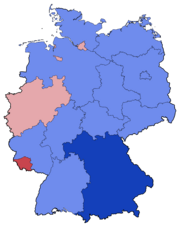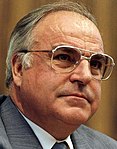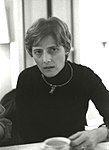1990 German federal election
| ||||||||||||||||||||||||||||||||||||||||||||||||||||||||||||||||||||||||||||||||||
All 662 seats in the Bundestag 332 seats were needed for a majority | ||||||||||||||||||||||||||||||||||||||||||||||||||||||||||||||||||||||||||||||||||
|---|---|---|---|---|---|---|---|---|---|---|---|---|---|---|---|---|---|---|---|---|---|---|---|---|---|---|---|---|---|---|---|---|---|---|---|---|---|---|---|---|---|---|---|---|---|---|---|---|---|---|---|---|---|---|---|---|---|---|---|---|---|---|---|---|---|---|---|---|---|---|---|---|---|---|---|---|---|---|---|---|---|---|
| Turnout | 77.8% (voting eligible)[1] | |||||||||||||||||||||||||||||||||||||||||||||||||||||||||||||||||||||||||||||||||
| ||||||||||||||||||||||||||||||||||||||||||||||||||||||||||||||||||||||||||||||||||
 Party list election results by state: dark blue denotes states where CSU had the absolute majority of the votes; lighter blue denotes states where CDU had the plurality of votes; red denotes states where the SPD had the absolute majority of the votes; and pink denotes states where the SPD had the plurality of votes | ||||||||||||||||||||||||||||||||||||||||||||||||||||||||||||||||||||||||||||||||||
| ||||||||||||||||||||||||||||||||||||||||||||||||||||||||||||||||||||||||||||||||||
German federal elections took place on 2 December 1990, to elect members to the 12th Bundestag (parliament) of the Federal Republic of Germany. It was the first free and universal election in all of Germany since the election of 1932 which cemented Adolf Hitler's power. The result was a comprehensive victory for the governing coalition of the Christian Democratic Union/Christian Social Union and the Free Democratic Party, which was reelected to a third term.
Issues and campaign
This was the first election conducted after German reunification which took place on 3 October. Almost 150 seats had been added to represent the newly re-established eastern states of Germany without reducing the number of Western members. The euphoria following the reunification gave the ruling CDU/CSU–FDP coalition a dramatic advantage in both Western and Eastern Germany throughout the campaign.
Results
| This article is part of a series on the |
| Politics of Germany |
|---|
 |
All change figures are relative to the pre-existing West German Bundestag.
Template:German federal election, 1990
This was the one and only election for which the 5% threshold was not applied nationwide, but separately for East and West. As a result, while the Western Greens failed to gain representation, an ideologically similar party from the East, Alliance 90, did.
| 319 | 79 | 239 | 17 | 8 |
| CDU/CSU | FDP | SPD | PDS |
Post-election
The governing CDU/CSU-FDP coalition was returned to office with a landslide majority, and Helmut Kohl remained chancellor. The CDU did exceptionally well in the former East Germany, which had been the heartland of the SPD before the Nazi era.

References
- ^ "Voter turnout by election year". Website of the Federal Returning Officer's Office. The Federal Returning Officer. Retrieved 7 November 2014.





